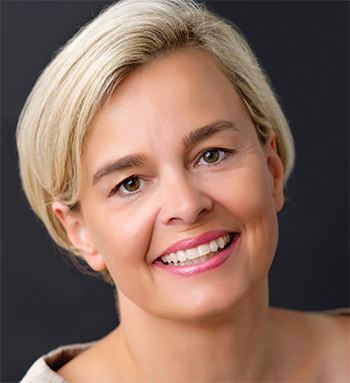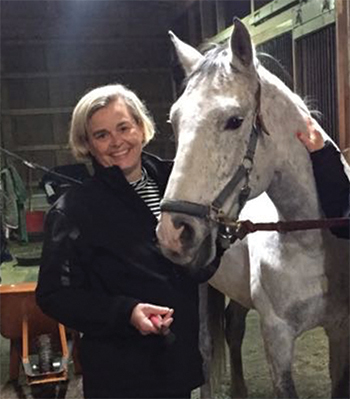From a Bavarian baccalaureate to bacterial bleach
Bleach, generally speaking, is bad news for anything it comes in contact with, whether it’s grime, blue jeans or bacteria waging war against your intestinal lining. At the University of Michigan, Ursula Jakob’s lab is investigating how to make the bacteria bent on colonizing your gut more sensitive to the bleach, or hypochlorous acid, that your white blood cells deploy against them. This form of bleach differs only slightly from the sodium hypochlorite in cleaning solutions that can strip dyes and burn clumsy hands.
 In 2000, Jakob received the Burroughs Wellcome Fund Career Award in the Biomedical Sciences, which helped jumpstart her career as an assistant professor at the University of Michigan.COURTESY OF THE UNIVERSITY OF MICHIGAN
In 2000, Jakob received the Burroughs Wellcome Fund Career Award in the Biomedical Sciences, which helped jumpstart her career as an assistant professor at the University of Michigan.COURTESY OF THE UNIVERSITY OF MICHIGAN
Jakob, who was born in Germany, received her bachelor’s degree in 1991 and her Ph.D. in 1995, both from the University of Regensburg in Bavaria. Throughout her college career, the lab she was in studied the heat-shock protein Hsp90 and its effect on protein folding as a molecular chaperone. Her current lab’s work involves the heat-shock protein Hsp33, a molecular chaperone that helps protect bacteria against the dangerous effects of bleach.
With a fellowship from the German government, Jakob did her postdoctoral research under James Bardwell at the University of Michigan, where she is now a professor in the molecular, cellular and developmental biology department and the university’s medical school. In 2014, she was elected to membership in the Bavarian Academy of Sciences and Humanities, one of the oldest learned societies in Germany. Since the academy’s inception in 1759, its members have included Johann Wolfgang von Goethe, Max Planck, Werner Heisenberg and Albert Einstein.
Jakob joined the ranks of associate editors at the Journal of Biological Chemistry in September. She spoke with John Arnst, ASBMB Today’s science writer, about her lab’s work exploring molecular chaperones and mechanisms of bleach resistance in bacterial and human cells. The interview has been edited for clarity and length.
What is your group focused on?
One of our most interesting projects involves bleach, which is not only a very effective antimicrobial in household settings but has long been known to be used in a physiological context — our white blood cells produce bleach, hypochlorous acid, to defend our bodies against infectious disease. We were wondering how bacteria defend themselves against bleach, and in 2008, we found that they produce a protein that gets specially activated in response to bleach and then protects the bacteria from it.
We use bleach in our host defense, and it works well most of the time to kill invading bacteria. However, some of the bacteria do survive and can cause persistent infections, and we still don’t know how they manage this feat. Moreover, under extreme conditions, like chronic inflammation in patients that suffer from cystic fibrosis or persistent infections, we see a lot of tissue damage. This is attributed to the excess bleach that’s being produced by our white blood cells.
And so the question then was, “What does bleach do, and how do organisms defend themselves against it?” The idea was that if we knew that, we could possibly make bacteria more sensitive to bleach. This might help with boosting the host defense and allowing the host to be more able to deal with bacterial infections while at the same time potentially mitigating the damage in the host. What we figured out is that bleach works as a really potent protein-denaturing agent, essentially boiling bacterial proteins at room temperature. In their defense, bacteria activate a chaperone, Hsp33, which protects the proteins against bleach-induced protein unfolding and aggregation and helps bacteria survive.
In the last few years, we took another approach and asked what other defense systems bacteria have to deal with bleach. We found that bacteria, in response to bleach treatment, convert a large amount of their ATP into a long chain of phosphates, polyphosphate. This molecule was the pet project of the late Arthur Kornberg in the last 15 years of his life; he was extremely fascinated by this prebiotic molecule and contributed a huge amount to the literature, including the fact that polyphosphate is present in every organism that had been studied so far.
In bacteria, polyphosphate plays a very important part in virulence. So this fits exactly with what we found: When we delete the gene that allows bacteria to make polyphosphate, they become super-sensitive to bleach. They’re no longer virulent, they no longer make biofilms as effectively as wild-type bacteria and they make many fewer antibiotic-resistant cells. So, we thought, this is really cool. If polyphosphate was indeed such an essential product in bacteria that they make it specifically under conditions of infections, then targeting that synthesis should make them much more sensitive to the host defense mechanisms.
We recently found a drug already on the market called mesalamine, which is widely used to treat colitis. We published a paper in Nature Microbiology a few months back, where we found that we can now target polyphosphate synthesis in bacteria in the intestines with mesalamine. It has basically the same effect as if you delete the enzyme from within the bacteria, making them sensitive to hypochlorous acid. Our hope now is that we can use this drug maybe alone or in combination with other antibiotics to treat particular persistent infections.
Did anything occur in a milestone sort of way that made you choose science as a career?
I was raised in a family that was very interested in biology and the environment. So it was not surprising to anybody when I decided to study biology. During my second year as a biology undergrad, I got hired in the lab where I ended up doing both my master’s thesis and Ph.D. thesis. We studied refolding of antibody fragments. Within about half a year or so after I started working there, my P.I. came to me and said, “I just saw this paper about this heat-shock protein, GroEL, being able to support refolding of a protein. Maybe we should put this into our antibody solution and see whether this helps in our refolding experiment.”
 Jakob often rides Agave, a Spanish horse she leases at Rosehill Dressage in Northville, Michigan.COURTESY OF URSULA JAKOB
Jakob often rides Agave, a Spanish horse she leases at Rosehill Dressage in Northville, Michigan.COURTESY OF URSULA JAKOB
The paper that he found in our library was really the landmark paper that started the chaperone era. So I was there when the chaperone field was born, and that was absolutely fascinating to me, to be part of such a new discovery. We were really in this first wave of chaperone research, which involved Hsp90. My first paper, still as an undergraduate, was a last-author Nature paper.
Everything we did was new. We developed the assays … it was just wonderful; we were in this full discovery mode. From the very beginning of my scientific career, we always tried to be on the forefront. From the very beginning, I learned that science is discovering something new.
When did you first become involved with JBC?
I was trained in a biophysics and physical biochemistry department, and JBC was always our go-to journal. I had six JBC papers during my graduate career. I’ve been a reviewer for years, and then I was asked whether I would like to take on an associate editor position at JBC.What do you do outside the lab? Do you have any advice for balancing life outside of the lab with life inside the lab?
I ride horses and I play tennis. I love riding horses because riding is a little bit like science — you never fully know where they will take you. And I love tennis because it’s competitive, and, you know, I’m slightly competitive, so I like that aspect. What I tell young assistant professors, in advisory roles, is that they absolutely need a balance. I had my first child three days after I started my lab, so when I see my daughter, who is now 16, I know exactly how long I’ve had my lab. And my son was born during my third-year review process.I think women in general, and this is very generally speaking, have a harder time with this balance between career and family, because they have a tendency to constantly feel guilty. We feel guilty about not being in the lab enough, about not having enough time for our children and of course not spending enough time with our partners, and the easiest thing to let go of is yourself and your friends. So I encourage young assistant professors to get as much help around the house as needed so you don’t have to waste the little time that you have with duties that you do not enjoy.
Enjoy reading ASBMB Today?
Become a member to receive the print edition four times a year and the digital edition monthly.
Learn moreGet the latest from ASBMB Today
Enter your email address, and we’ll send you a weekly email with recent articles, interviews and more.
Latest in People
People highlights or most popular articles

Sketching, scribbling and scicomm
Graduate student Ari Paiz describes how her love of science and art blend to make her an effective science communicator.

Embrace your neurodivergence and flourish in college
This guide offers practical advice on setting yourself up for success — learn how to leverage campus resources, work with professors and embrace your strengths.

Survival tools for a neurodivergent brain in academia
Working in academia is hard, and being neurodivergent makes it harder. Here are a few tools that may help, from a Ph.D. student with ADHD.

Quieting the static: Building inclusive STEM classrooms
Christin Monroe, an assistant professor of chemistry at Landmark College, offers practical tips to help educators make their classrooms more accessible to neurodivergent scientists.

Hidden strengths of an autistic scientist
Navigating the world of scientific research as an autistic scientist comes with unique challenges —microaggressions, communication hurdles and the constant pressure to conform to social norms, postbaccalaureate student Taylor Stolberg writes.

Richard Silverman to speak at ASBMB 2025
Richard Silverman and Melissa Moore are the featured speakers at the ASBMB annual meeting to be held April 12-15 in Chicago.

